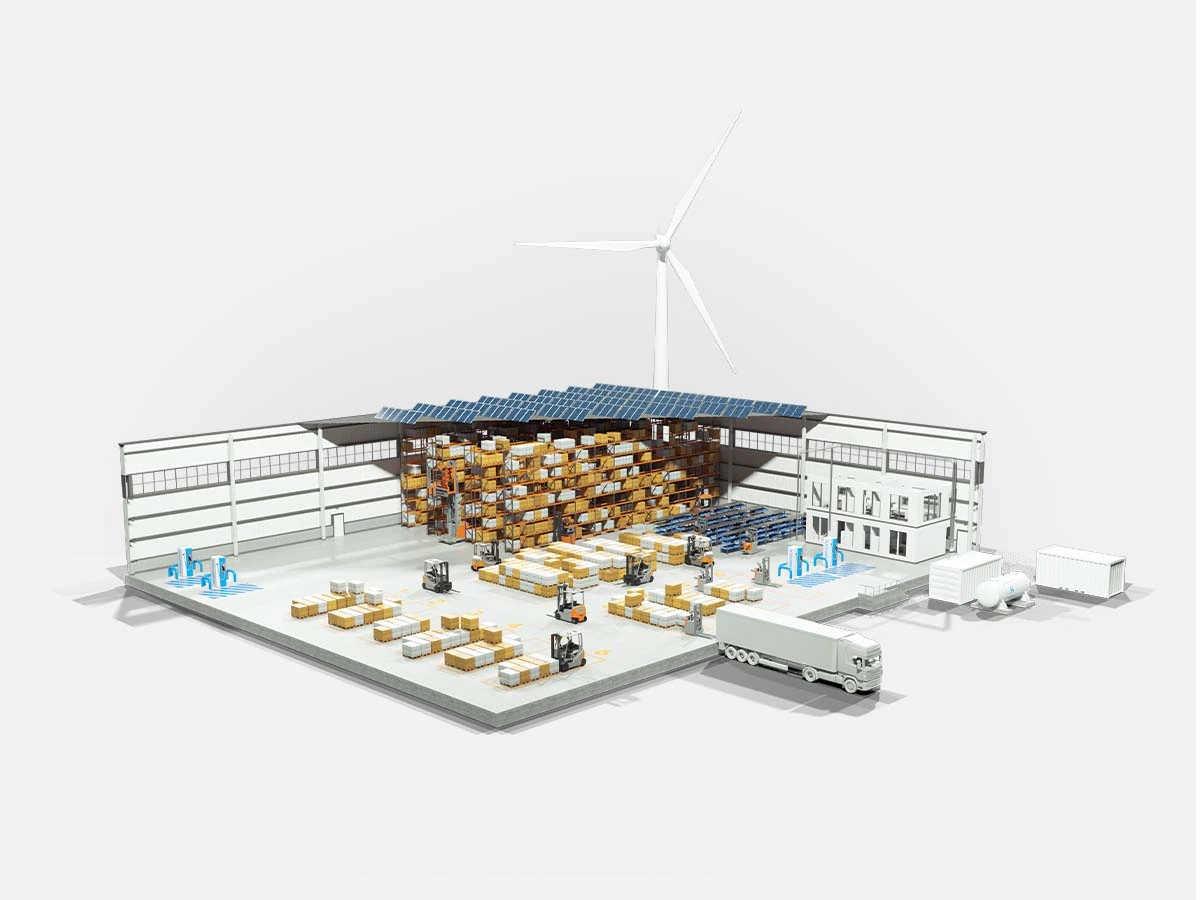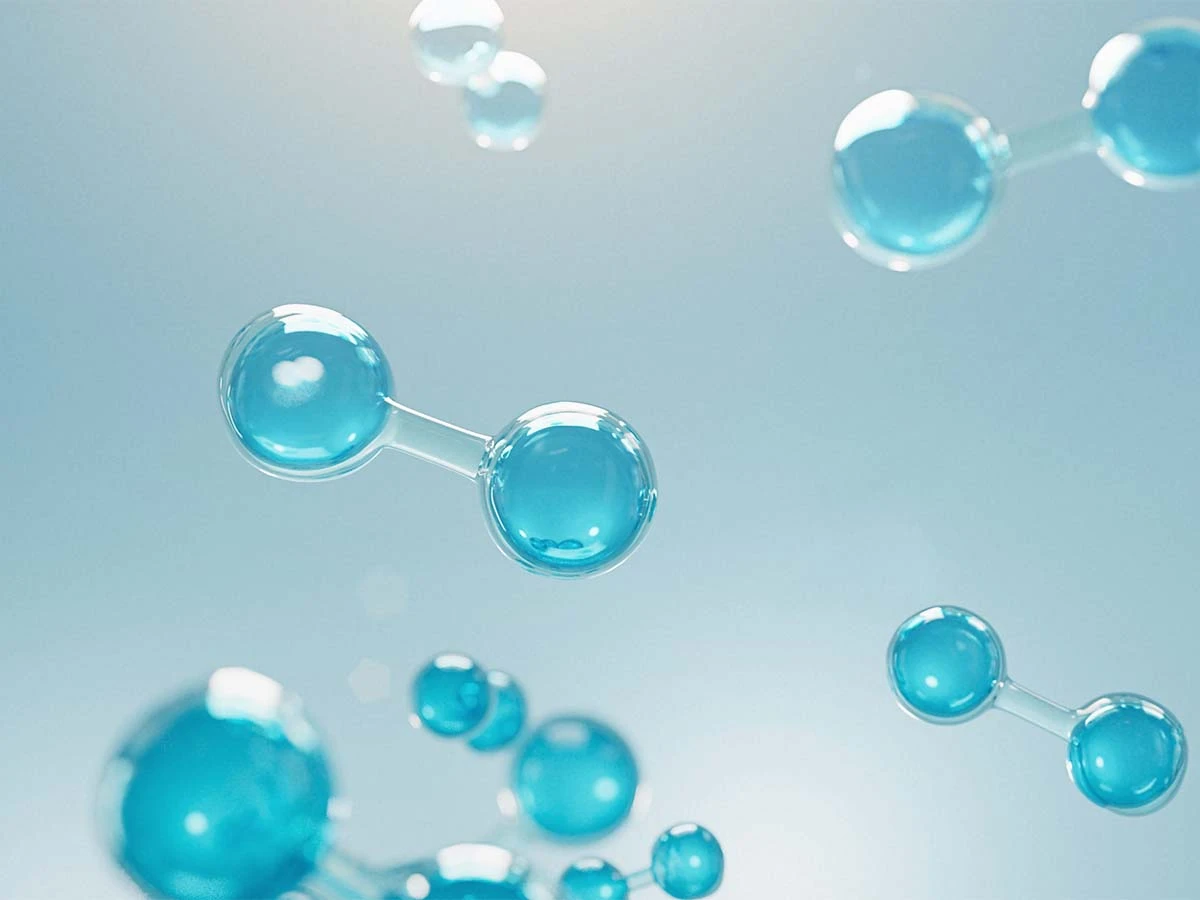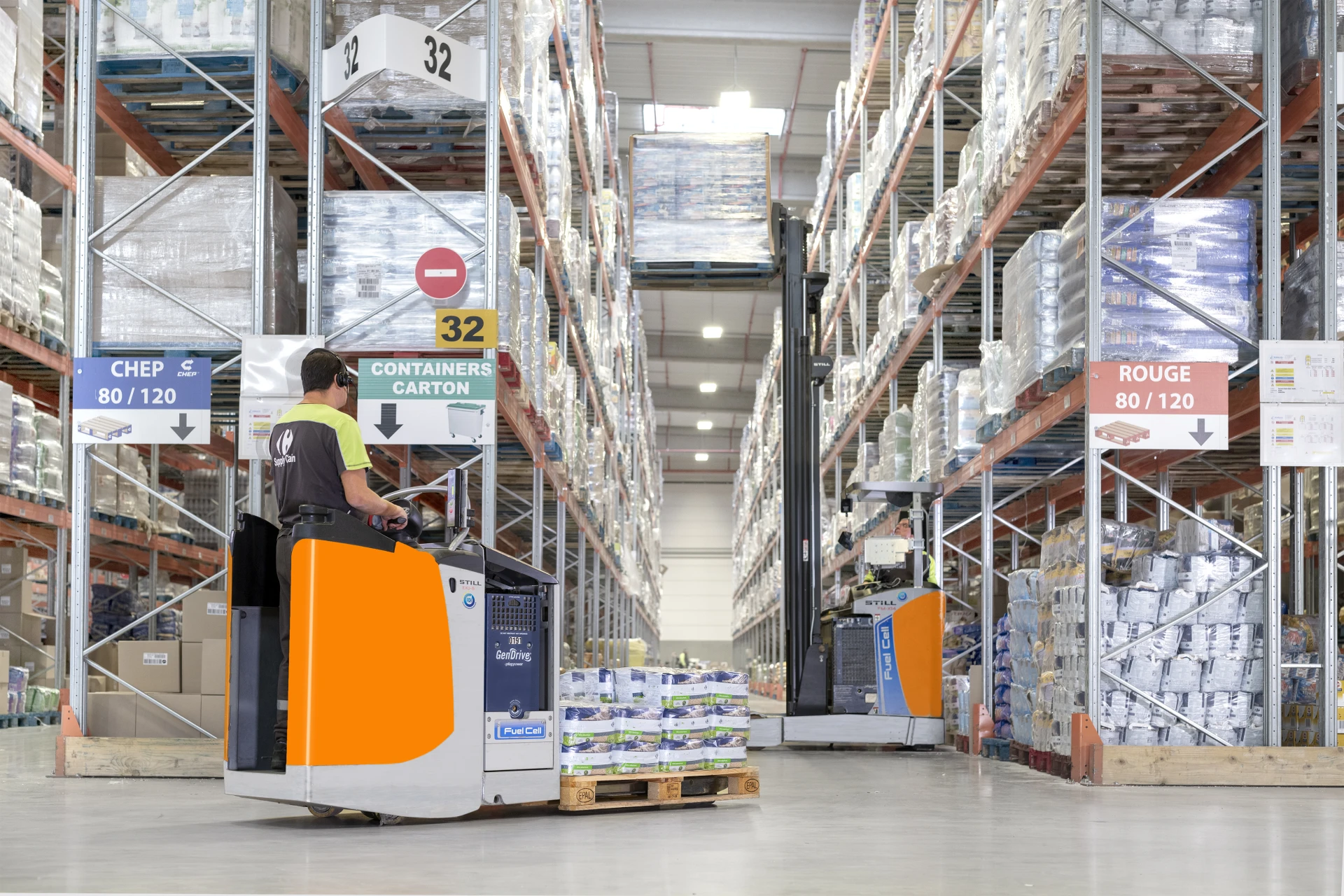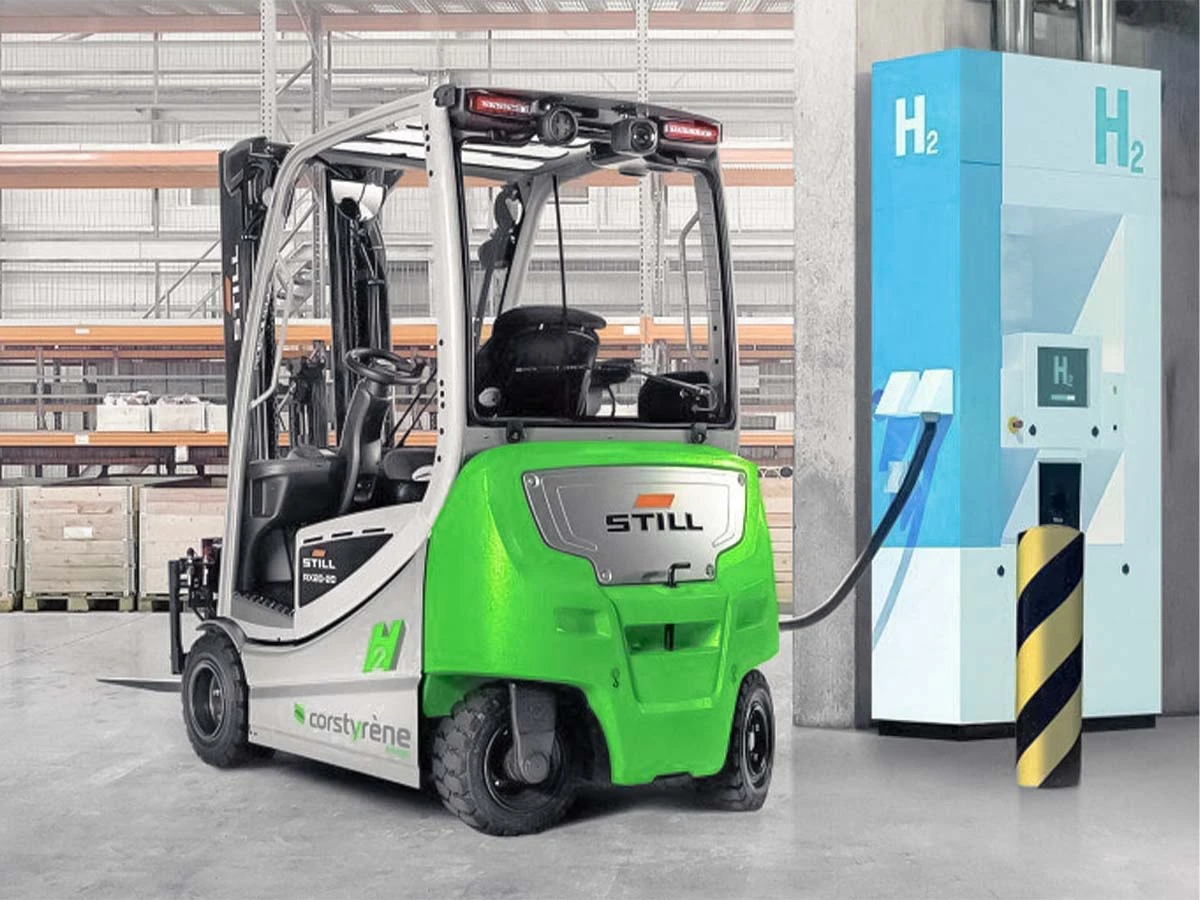
STILL Fuel Cell Technology
Latest fuel cell technology in the second generation
Powering intralogistics with hydrogen
Having to choose between cost-effective intralogistics and taking a climate-neutral approach has long been a thing of the past. Innovative energy systems like fuel cell technology allow you to run your industrial trucks in seamless multi-shift operation, without producing CO2 emissions in the process. This is achieved by using of sustainably produced, green hydrogen.


Application
- Saves time as there is no need to change battery
- High truck availability due to quick filling time of approx. 2–3 minutes
- Continuous energy supply with no drops in performance
- Indoor and outdoor use with operating times of up to 8 hours

Infrastructure
- Space-saving and flexible integration of dispensers (fuel pumps) along the transport routes
- No storage or charging rooms required
- No ventilation systems required
- Hydrogen can be generated in-house using electrolysis

Environmentally friendly
- Zero emissions – only ‘waste products’ are water/steam
- Clean energy source – ideal for hygiene-critical industries
- Reduction of carbon footprint2-Footprints
Trucks with fuel cells
STILL offers you the option of ordering selected trucks as a ‘fuel cell ready’ version ex works, which works in a similar way to the ‘Li-ion ready’ option. With this option, the truck is designed to accommodate a specific fuel cell, and the fuel cell can be integrated, subsequently if need be, as per the customer’s wishes.
The more hydrogen-powered industrial trucks in operation, the more efficient the fuel cell energy system. That is why we have 24 V, 48 V and 80 V fuel cell systems available for our portfolio of order pickers, tow tractors, high lift pallet trucks, reach trucks and counterbalanced forklift trucks.
Generally speaking, fuel cell technology is ideal for truck applications with a high number of operating hours or multi-shift operations.


In-house produced fuel cell systems
The production facility at the Hamburg plant, which opened at the end of 2023, produces a 24-volt fuel cell system specially developed for STILL warehouse trucks. This makes STILL the only manufacturer in the intralogistics industry in Europe to offer its customers a solution for a sustainable and efficient energy supply from a single source.
Another advantage of working with STILL is that customers receive comprehensive advice on fuel cell technology. Thanks to the partnership with experts in hydrogen projects, customers receive individual and customised advice tailored to their specific needs.
Components of the hydrogen infrastructure
When making the switch to a fuel cell energy system, it is important to ensure that you have the right trucks as well as the necessary infrastructure. This basically comprises the following:
- Trucks with fuel cells
- Hydrogen filling stations (dispensers)
- Hydrogen storage facilities
- A supply of hydrogen, e.g. through deliveries or in-house production (electrolysis)
As your intralogistics partner, STILL provides fuel cell trucks and works with its internationally renowned partners to ensure that a comprehensive energy solution (fuel cells and fuel infrastructure) can be put in place.

We are there for you.
Do you have any questions or would you like personal advice?
Then you've come to the right place. Our team of experts will take care of your request - individually and quickly.
Call a consultant
We are there for you – Monday to Friday
Use the contact form
Write to us – we will get back to you
Hydrogen as an energy source
A compact molecule with a lot of energy. In the world of energy sources, hydrogen is the future. Thanks to the use of regeneratively produced electricity, it can be produced in a climate-neutral way, and is ideal for industrial applications, heat and power generation, as well as for mobility and intralogistics. Hydrogen is 14 times lighter than air, non-toxic, non-corrosive and non-radioactive. Hydrogen is not susceptible to spontaneous combustion, and burns cleanly with a colourless flame. In short, hydrogen is packed full of energy and can be produced as a greener, carbon-neutral sustainable energy source.

Fuel cells in intralogistics
When we talk about fuel cells in the industrial trucks sector, we mean ‘battery replacement modules’ (BRMs). A BRM is a closed system and corresponds to a specific battery compartment in its shape, size and weight. The BRM contains all the components required to generate electricity. These include the fuel cells, the hydrogen tank, tank ports and a small lithium-ion battery, as well as other components.
Once the tank is filled with hydrogen, which only takes a few moments, the fuel cell produces electrical energy for the intended application directly on board the truck. The process generates emissions of pure water vapour or water. The integrated lithium-ion battery acts as an energy store, supplying the truck with a constant flow of energy. Through this process, any excess or recovered energy is stored temporarily, which means that the truck can easily cater for peaks in electricity consumption, e.g. when lifting a load.

Carrefour
Back in 2018, the French retail company Carrefour introduced a hydrogen-powered fleet of 137 STILL warehouse technology trucks into its new logistics centre in Vendin-Le-Vieil in northern France. With its two-phase HyLIFT-EUROPE project, which was funded by the EU, the partners are setting a milestone for the use of hydrogen as an alternative energy source and demonstrating that this technology is reliable in tough day-to-day logistics.

Corstyrène
In late 2021, the first-ever green hydrogen filling station on the island of Corsica is set to open, at the production site of the specialist thermal insulation company Corstyrène in Aléria. The electrolyser used to produce the hydrogen required will be supplied with up to 99 kWc from solar panels installed on the plant’s car park. In the first phase, this will produce enough energy to fill seven STILL RX 20 fuel cell forklift trucks.
With "Green EU 2050", the EU has set a target to become climate-neutral by 2050. The main aim is to prevent CO2 emissions. One approach to reducing greenhouse gases is using green hydrogen, H2, which can be converted into energy and heat in a climate-neutral process. The use of green hydrogen in intralogistics therefore offers significant leverage when it comes to completely avoiding CO2 emissions. When used in combination with other logistical applications, such as a hydrogen-powered fleet of heavy goods trucks, the synergies can be exploited and the operating costs heavily reduced.
In order to achieve the "Green EU" goal, "green hydrogen" must be produced and used. The color of the hydrogen refers to the extraction process. Green hydrogen is produced from sustainable non-depletable energy sources, e.g. by using energy from wind power or photovoltaics. In distinction to this, there is "gray hydrogen", which is still in use today. In the production of gray hydrogen, natural gas is usually converted into hydrogen and CO2 under heat (steam reforming). The CO2 is then released unused into the atmosphere, thus increasing the global greenhouse effect: the production of one ton of hydrogen produces about 10 tons of CO2 . Blue hydrogen is gray hydrogen, but its CO2 is captured and stored during production (Carbon Capture and Storage, CCS). The CO2 generated during hydrogen production is thus not released into the atmosphere, and hydrogen production can be considered CO2 -neutral in balance sheet terms. Hydrogen produced by the thermal decomposition of methane (methane pyrolysis) is called turquoise hydrogen. Instead of CO2 , solid carbon is produced in the process.
In a fuel cell, the refueled hydrogen is converted into water with the addition of atmospheric oxygen. This chemical reaction generates electrical energy that is used to power the vehicle.
When we talk about fuel cells in the industrial trucks sector, we mean ‘battery replacement modules’ (BRMs). A BRM is a closed system and corresponds to a specific battery compartment in its shape, size and weight. The BRM contains all the components required to generate electricity. These include the fuel cells, the hydrogen tank, tank ports and a small lithium-ion battery, as well as other components.
Once the tank is filled with hydrogen, which only takes a few moments, the fuel cell produces electrical energy for the intended application directly on board the truck. The process generates emissions of pure water vapour or water. The integrated lithium-ion battery acts as an energy store, supplying the truck with a constant flow of energy. Through this process, any excess or recovered energy is stored temporarily, which means that the truck can easily cater for peaks in electricity consumption, e.g. when lifting a load.
Fuel cells for intralogistics applications are designed to run up to one shift. However, the real range depends on the respective customer application. The great advantage of a fuel cell is the enormously short refueling time of 2-3 minutes.
No. STILL currently only offers the "Fuel Cell-ready" option at the factory. Retrofitting existing vehicles is not possible.
The hydrogen required is comparable to diesel fuel for internal combustion engine forklifts. However, hydrogen differs in terms of production, transport, storage and the necessary safety precautions. The infrastructure can vary - depending on whether the hydrogen is to be produced on the premises by electrolysis itself or delivered by trailer. Possible components are therefore:
- Hydrogen trailer, if H2 is delivered
- Hydrogen electrolyzer, if H2 is produced on site, e.g. by wind power or photovoltaics
- High pressure compressor High-pressure intermediate storage
- Pipeline system Dispenser (dispenser for H2 refueling)
For the operation, refueling and storage of a fuel cell or fuel cell-powered vehicle in conjunction with a hydrogen infrastructure, national and/or regional laws/regulations must be observed. Depending on the location, local regulatory agencies, fire departments, and insurance companies should be involved in the planning and construction. For the construction of the hydrogen infrastructure, there are specialised planners and construction experts who can provide advice.
There are different institutions that provide funding, including:
- Europe:
- Fuel Cell and Hydrogen Joint Undertaking, Funding & Financing | www.fch.europa.eu
- Germany
- National Hydrogen and Fuel Cell Technology Innovation Programme (NIP)
www.now-gmbh.de/de/bundesfoerderung-wasserstoff-und-brennstoffzelle - Project Management Organisation Jülich: https://www.ptj.de/projektfoerderung
- Regionale funding programmes via state governments
- National Hydrogen and Fuel Cell Technology Innovation Programme (NIP)
- France:
- ADEME (Agence de la Transition Écologique)
Climate change - ecological, energy transition - ADEME
- ADEME (Agence de la Transition Écologique)
The funding programmes are limited in time and set up with a fixed budget. As a rule, an interested party must apply for the funding budget via a funding application and competes with other applicants. The focus is on the volume of CO2 savings. The higher the savings, the higher the probability of a positive funding response.
Varies depending on the funding programme. The NOW GmbH funding call (2020), for example, had a volume of 5 million euros. Eligible for funding were industrial trucks with hydrogen drive to the extent of 40% of the additional investment costs compared to the "normal" vehicle. For 2021, the third funding call of the NIP is also planned with a funding quota of 40% of the additional investment costs. In addition to the industrial trucks, the necessary hydrogen infrastructure will also be funded again. A current overview of the funding calls can be found here: Funding calls - NOW GmbH.
Example for calculating the funding amount:
| Costs for forklift truck (battery) | 30.000€ |
| Costs for forklift truck (fuel cell) | 55.000€ |
| Additional investment costs (battery vs. fuel cell) | 25.000€ |
| Funding rate according to NIP | 40% |
| Funding per forklift | 10.000€ |
Downloads
We are there for you.
Do you have any questions or would you like personal advice?
Then you've come to the right place. Our team of experts will take care of your request - individually and quickly.
Call a consultant
We are there for you – Monday to Friday
Use the contact form
Write to us – we will get back to you
